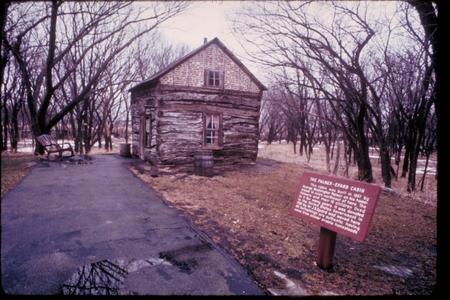At Nebraska's Homestead National Monument of America, the Homestead Act sesquicentennial celebration in 2012 will feature a symposium exploring key developments of 1862, a monumentally important year in U.S. history.
Homestead National Monument of America is located four miles west of Beatrice (pronounced Be-ATT-russ) in southeastern Nebraska. It was on a 160-acre tract of this 211-acre national park that Ohio native and Civil War veteran Daniel Freeman became America's first homesteader ( as far as we can tell) after filing a claim just after midnight on January 1, 1863, the day that the Homestead Act of 1862 went into effect. (It was also on this day that Lincoln's Emancipation Proclamation went into effect.) Freeman proved to be tough, persistent, and versatile. He not only "proved up" his claim and got his deed of title, but also worked as a physician (his primary occupation), served as sheriff and coroner, and won a landmark separation of church and state lawsuit.
Daniel Freeman died on December 30, 1908. In the early 1930s, his descendants agreed to sell the land to the federal government for purposes of creating a national monument to homesteading and the Homestead Act. On March 19, 1936, President Franklin D. Roosevelt signed legislation creating Homestead National Monument of America. The park now entertains and educates about 70,000 visitors a year with the restored Palmer-Epard Cabin (1867), the Freeman School (1872), the Homestead Heritage Center (dedicated 2007), an Education Center, hiking trails through 100 acres of restored tallgrass prairie, a burr oak forest, and other attractions and special events.
President Abraham Lincoln signed the Homestead Act into law in 1862 (May 20, 1862, to put a finer point on it), so the150th anniversary celebration of this remarkable piece of legislation will take place in 2012. Homestead National Monument of America will naturally garner a good deal of publicity, and with it, more visitors.
Symposium Planning
Although the sesquicentennial celebration is still many months away, the park is already planning a number of commemorative activities . A major academic conference will be one of the high-profile events. The park is partnering with the Center for Great Plains Studies at the University of Nebraska-Lincoln to host an interdisciplinary symposium that will examine both the immediate and long term effects of the Homestead Act and other important legislation and government initiatives of 1862.
The symposium has been scheduled for March 2012, with events being held at both the University of Nebraska-Lincoln campus and Homestead National Monument of America.
Primary Topics
The Homestead Act, which permitted claimants to file for 160 acres of free land (then considered sufficient to support a farm family), will naturally be at the center of attention. It was, after all, one of the most important pieces of legislation in the history of the United States. Before it was repealed by the 1976 Federal Land Policy and Management Act (with a ten-year extension for Alaska homesteading), the Homestead Act resulted in the distribution of more than 270 million acres of federal government-owned land in 30 states.
The symposium will also examine three other landmark government initiatives originating in 1862: the Morrill Act; the Pacific Railroad Act; and the creation of the US Department of Agriculture. Like the Homestead Act, all three are included on the top 100 milestone documents list compiled by the National Archives and Records Administration. Collectively, these four government actions, emerging during the turmoil of the Civil War, provided the framework for, and revealed the federal government's vision for, the future development of the Great Plains. They also fundamentally shaped the society and culture of the region for generations to come.
The Morrill Act of 1862 (aka Land Grant College Act) promoted higher education in America by providing for land grant colleges. Each state (Confederate states excepted, initially) received 30,000 acres of public land for each Senator and Representative, the land to be sold to raise money to support colleges emphasizing agricultural and technical/mechanical education. The schools created in this way are still called land grant colleges.
The Pacific Railroad Act of 1862, the first of four Pacific Railroad Acts, authorized the construction of America's first transcontinental railroad and provided land grants and loans for that purpose. The Union Pacific Railway then began construction at Omaha, Nebraska, and the Central Pacific Railroad began in Sacramento, California. One of the epic achievements of the 19th century was accomplished on May 10, 1869, when the two lines were officially joined at the Promontory Point, Utah, site now preserved and interpreted at Golden Spike National Historic Site.
The creation of the US Department of Agriculture was yet another major initiative launched in 1862. On May 15 of that year President Lincoln referred to the new agency as the "people's department" when he created it by executive action. Prior to that time there were just Agriculture Committees in Congress. Now there would be a federal government agency advancing the interests of the millions of farm and ranch families who tended the land and fed the country.
Contacts
If you have questions about the symposium, contact the UNL Center by phone (402) 472-3082 or by e-mail at . Although not yet activated, this site will provide more information about the symposium and a complete call for papers. The deadline for paper proposals is November 1, 2011.
For information about other commemorative events scheduled to take place at Homestead National Monument of America during the Homestead Act 150th anniversary year, contact the park by phone at 402-223-3514. Current hours of operation are 8:30 a.m. to 5 p.m. weekdays and 9 a.m. to 5 p.m. weekends.


 Support Essential Coverage of Essential Places
Support Essential Coverage of Essential Places







Add comment